 W
WBlodplättar, or blood pancakes in English, are a dish served in Finland, Estonia, Sweden and Norway made of whipped blood, water or pilsner, flour and eggs. It is similar to black pudding, but is thinner and crispier.
 W
WBoknafisk is a variant of stockfish and is unsalted fish partially dried by sun and wind on drying flakes ('hjell') or on a wall.
 W
WIn classical French cuisine, a brown sauce is generally a sauce with a meat stock base, thickened by reduction and sometimes the addition of a browned roux, similar in some ways to but more involved than a gravy. The classic mother sauce example is espagnole sauce as well as its derivative demi-glace, though other varieties exist.
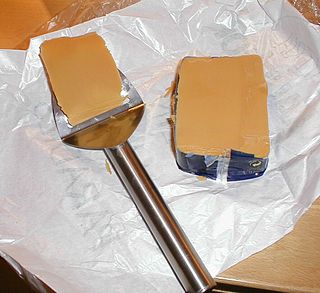 W
WBrunost is a common Norwegian name for mysost, a family of cheese-related foods made with whey, milk, and/or cream. The term is often used to just refer to the Gudbrandsdalsost type, which is the most popular variety. Brunost is primarily produced in Norway and is popular in both Norway and South Korea. It is regarded as one of the country's most iconic foodstuffs, and is considered an important part of Norwegian gastronomical and cultural identity and heritage.
 W
WA Danish pastry, sometimes shortened to just Danish, is a multilayered, laminated sweet pastry in the viennoiserie tradition. The concept was brought to Denmark by Austrian bakers, and has since developed into a Danish specialty. Like other viennoiserie pastries, such as croissants, it is a variant of puff pastry made of laminated yeast-leavened dough that creates a layered texture.
 W
WDried and salted cod, sometimes referred to as salt cod or saltfish or salt dolly, is cod which has been preserved by drying after salting. Cod which has been dried without the addition of salt is stockfish. Salt cod was long a major export of the North Atlantic region, and has become an ingredient of many cuisines around the Atlantic and in the Mediterranean.
 W
WFenalår is a traditional Norwegian cured meat made from salted and dried leg of lamb. Fenalår is a very popular dish in Norway and is often served with other preserved food at a Christmas buffet or at Norwegian Constitution Day.
 W
WFilmjölk, also known as fil, is a traditional fermented milk product from Sweden, and a common dairy product within the Nordic countries. It is made by fermenting cow's milk with a variety of bacteria from the species Lactococcus lactis and Leuconostoc mesenteroides. The bacteria metabolize lactose, the sugar naturally found in milk, into lactic acid which means people who are lactose intolerant can tolerate it better than other dairy products. The acid gives filmjölk a sour taste and causes proteins in the milk, mainly casein, to coagulate, thus thickening the final product. The bacteria also produce a limited amount of diacetyl, a compound with a buttery flavor, which gives filmjölk its characteristic taste.
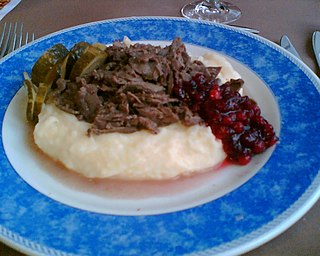 W
WSautéed reindeer is perhaps the best known traditional meal from Lapland, especially in Finland, Sweden, Norway and Russia and Sakha. Usually steak or the back of the reindeer is used. It is sliced thinly, fried in fat, spiced with black pepper and salt, and finally some water, cream, or beer is added and it is cooked until tender. The dish is served with mashed potatoes and lingonberry preserves or, more traditionally, with raw lingonberries mashed with sugar. In Finland it is often served with pickled cucumber, which is not as common in Sweden.
 W
WFish balls are rounded meat balls made from fish paste which are then boiled or deep fried. Similar in composition to fishcake, fish balls are often made from fish mince or surimi, salt, and a culinary binder such as tapioca flour, corn, or potato starch.
 W
WFreia Melkesjokolade is a Milk Chocolate from the Norwegian chocolate brand Freia and has been the most sold chocolate in Norway since the 1960s. The chocolate was launched in 1906 after a Swiss recipe, originally called 'Freia Melkechokolade'. In the 1920s it was considered ”Europas bedste spisechokolade”, and people would often add that it was Norwegian, to underline that it was not imported. It was only after the chocolate again became available after World War II, that the name was changed to "Melkesjokolade" due to the spelling reform of 1939.
 W
WFrikadelle are flat, pan-fried meatballs of minced meat, often likened to the Danish version of meatballs. The origin of the dish is unknown. The term "frikadelle" is German but the dish is associated with Danish, Scandinavian and Polish cuisines as well as German cuisine. It is considered a national dish in Denmark. They are one of the most popular meals in Poland, where they are known as "kotlety mielone". In Norway, the dish is known as Kjøttkaker.
 W
WGomme is a traditional Norwegian dish usually served as a spread or a dessert.
 W
WGoro is a traditional Norwegian sweet bread.
 W
WPizza Grandiosa refers to the most popular brand of frozen pizza in Norway. Grandiosa can also refer to the series of different Grandiosa variants. Grandiosa is Italian for great or grand.
 W
WGravlax or graved salmon is a Nordic dish consisting of salmon that is cured using a mix of salt and sugar, and either dill or sprucetwigs placed on top, and may occasionally be cold-smoked afterwards. Gravlax is usually served as an appetizer, sliced thinly and accompanied by hovmästarsås, a dill and mustard sauce, either on bread or with boiled potatoes.
 W
WJulebord is a Scandinavian feast or banquet during the Christmas season where traditional Christmas food and alcoholic beverages are served often in the form of a buffet. Originally, the julebord belonged to Christmas itself, i.e. the period from Christmas Day and onwards. Today julebord is often organized by employers or organizations for the employees or members. Scandinavian feast or banquet during the Christmas season where traditional Christmas food and alcoholic beverages are served often in the form of a buffet. Originally, the julebord belonged to Christmas itself, i.e. the period from Christmas Day and onwards. Today julebord is often organized by employers or organizations for the employees or members.
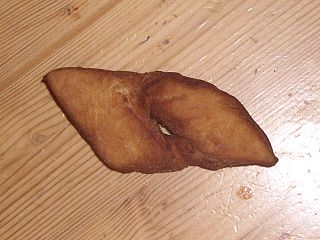 W
WKlenät, kleinur, klena, klejne, kleina, kleyna, and fattigmann are all names for Angel wings, a fried pastry common in the Nordic countries as well as the rest of Europe and the United States. In nearby countries and Eastern European countries. The name is related to klen, the Swedish term for "slender", but is originally of Low German origin, which may indicate that the pastry was originally German. It is made from flattened dough cut into small trapezoids. A slit is cut in the middle and then one or both ends pulled through the slit to form a "knot". The kleina is then deep-fried in oil or another kind of fat. Subsequently can be sprinkled with powdered sugar and cinnamon.
 W
WKringle is a Northern European pastry, a variety of pretzel. Pretzels were introduced by Roman Catholic monks in the 13th century in Denmark, and from there they spread throughout Scandinavia and evolved into several kinds of sweet, salty or filled pastries, all in the shape of kringle.
 W
WKrotekake is a traditional Norwegian flatbread. It is traditionally associated with the region of Hardanger and is commonly decorated with a cross-hatch pattern. Outside of the region it is often known as hardangerkaker .
 W
WKvikk Lunsj is the name of a chocolate bar that was launched by the Norwegian chocolate sweets manufacturing company, Freia, in 1937 and has been sold ever since — with the exception of a period during and after WWII. Between 1941 and 1949, production was halted due to a shortage of sugar and the lack of quality flour. The chocolate consists of four rectangular wafers covered in milk chocolate, with thinner layers of filler made from ground up discarded wafers and bars mixed with chocolate that is put between wafers in order to break the chocolate into pieces easier. The chocolate has been advertised as a "hiking chocolate", and it is often associated with skiing trips in Norwegian culture, especially during Easter vacation, where chocolate is often used to provide extra energy in packed lunches. Kvikk Lunsj is today owned and produced by Mondelez International and sold in Norway, Sweden, and Denmark.
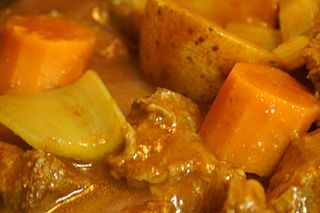 W
WLapskaus is a thick Norwegian stew made of meat and potatoes. There are many variations of lapskaus. The dish may be made of fresh or leftover meat and potatoes. Other typical ingredients are vegetables and spices.
 W
WLefse is a traditional soft Norwegian flatbread. It is often made with potatoes, flour, butter, and milk, cream, or lard. It is cooked on a large, flat griddle. Special tools are used to prepare lefse, including long wooden turning sticks and special rolling pins with deep grooves.
 W
WLingonberry jam is a staple of Northern European cuisine and otherwise highly popular in Central and Eastern Europe. Lingonberries grow on a short evergreen shrub in the Arctic tundra throughout the Northern Hemisphere from Eurasia to North America.
 W
WLiver pâté is a pâté and meat spread popular in Northern and Eastern Europe. Made from finely or coarsely ground pork liver and lard, it is similar to certain types of French and Belgian pâtés.
 W
WLutefisk is dried whitefish. It is made from aged stockfish, or dried and salted cod, pickled in lye. It is gelatinous in texture after being rehydrated for days prior to eating.
 W
WMashed potato, mashed potatoes or mashed taters, colloquially known as mash, is a dish made by mashing boiled potatoes, usually with added milk, butter, salt and pepper. It is generally served as a side dish to meat or vegetables. When the potatoes are only roughly mashed, they are sometimes called smashed potatoes. Dehydrated instant mashed potatoes and frozen mashed potatoes are available. Mashed potatoes are an ingredient in other dishes, such as dumplings and gnocchi.
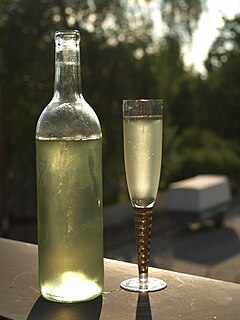 W
WMead is an alcoholic beverage created by fermenting honey with water, sometimes with various fruits, spices, grains, or hops. The alcoholic content ranges from about 3.5% ABV to more than 18%. The defining characteristic of mead is that the majority of the beverage's fermentable sugar is derived from honey. It may be still, carbonated, or naturally sparkling; dry, semi-sweet, or sweet.
 W
WMedisterpølse, medisterkorv or simply medister, is a Scandinavian specialty food consisting of a thick, spiced sausage made of minced pork and suet, stuffed into a casing. It is a slightly sweet-tasting sausage and the finely-ground meat is seasoned with chopped onion, allspice, cloves, salt and pepper. It is a traditional dinner sausage in Danish cuisine.
 W
WNettle soup is a traditional soup prepared from stinging nettles. Nettle soup is eaten mainly during spring and early summer, when young nettle buds are collected. Today, nettle soup is mostly eaten in Scandinavia, Iran, Ireland, and Eastern Europe, with regional differences in recipe; however historically consumption of nettles was more widespread.
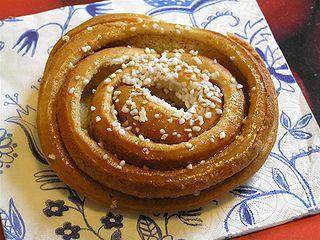 W
WNib sugar is a product of refined white sugar. The sugar is very coarse, hard, opaque white, and does not melt at temperatures typically used for baking. The product usually is made by crushing blocks of white sugar, then sifting to obtain fragments of a given diameter. The sugar may also be made in an extrusion process.
 W
WNugatti is a Norwegian brand of chocolate spread made from hazelnuts and nougat. It comes in ordinary or economy-sized plastic tubs, or the latest addition, a small red tube, similar to toothpaste tubes, and is produced by Stabburet.
 W
WAn open sandwich, also known as an open-face/open-faced sandwich, bread baser, bread platter, half-widge or tartine, consists of a slice of bread or toast with one or more food items on top.
 W
WPinnekjøtt is a traditional Norwegian main course dinner dish based on lamb ribs. Pinnekjøtt is a festive dish typical to Western and Northern Norway, and is rapidly gaining popularity in other regions as well. This dish is largely associated with the celebration of Christmas and frequently paired with puréed rutabaga, sausages and potatoes, served beer and akevitt.
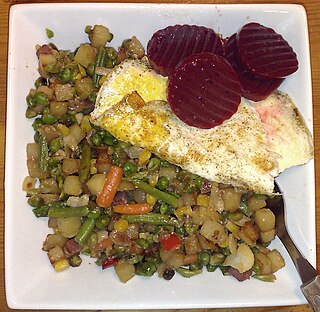 W
WPytt i panna, also pytt i panne, pytt i panne (Norwegian), pyttipannu (Finnish), is a culinary dish consisting of chopped meat, potatoes, and onions fried, similar to a hash. The term is Swedish for "small pieces in pan". It is a popular dish in Sweden, Norway and Finland, and in Denmark, where it bears the name biksemad, literally meaning "mixed food".
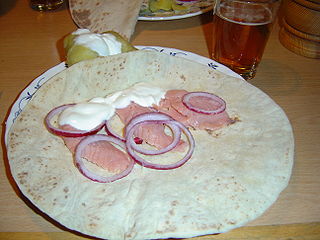 W
WRakfisk is a Norwegian fish dish made from trout or char, salted and autolyzed for two to three months, or even up to a year. Rakfisk is then eaten without cooking and has a strong smell and a pungent salty flavor.
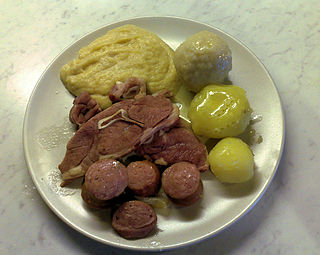 W
WPotetball is a traditional Norwegian potato dumpling. A similar German dish is called Kartoffelklöße.
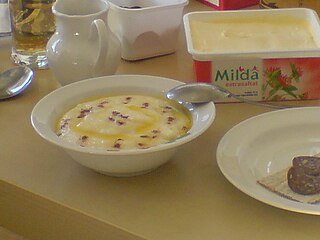 W
WRømmegrøt, also known as rømmegraut (Nynorsk) and römmegröt (Swedish), is a Norwegian porridge made with sour cream, whole milk, wheat flour, butter, and salt.
 W
WRubus chamaemorus is a species of flowering plant in the rose family Rosaceae, native to cool temperate regions, alpine and arctic tundra and boreal forest. This herbaceous perennial produces amber-colored edible fruit similar to the blackberry. English common names include cloudberry, nordic berry, bakeapple, knotberry and knoutberry, aqpik or low-bush salmonberry, and averin or evron.
 W
WSámi cuisine is the cuisine of peoples from the Sápmi territory of the Sámi people, which spans Norway, Sweden, Finland and Russia. Its traditional cuisine of each area has individual traits.
 W
WThis is an incomplete list of Sami dishes and other dishes related to the culture of the Sami people, which spans Norway, Sweden, Finland and Russia as well.
 W
WSautéed reindeer is perhaps the best known traditional meal from Lapland, especially in Finland, Sweden, Norway and Russia and Sakha. Usually steak or the back of the reindeer is used. It is sliced thinly, fried in fat, spiced with black pepper and salt, and finally some water, cream, or beer is added and it is cooked until tender. The dish is served with mashed potatoes and lingonberry preserves or, more traditionally, with raw lingonberries mashed with sugar. In Finland it is often served with pickled cucumber, which is not as common in Sweden.
 W
WSeal meat is the flesh, including the blubber and organs, of seals used as food for humans or other animals. It is prepared in numerous ways, often being hung and dried before consumption. Historically, it has been eaten in many parts of the world, both as a part of a normal diet, and as sustenance.
 W
WA semla, vastlakukkel, laskiaispulla or fastlagsbulle/fastelavnsbolle is a traditional sweet roll made in various forms in Sweden, Finland, Estonia, Norway, Denmark, the Faroe Islands and Iceland, associated with Lent and especially Shrove Tuesday in most countries, Shrove Monday in Denmark, parts of southern Sweden, Iceland and Faroe Islands or Sunday of Fastelavn in Norway. In Sweden it is most commonly known as just semla, but is also known as fettisdagsbulle. In the southern parts of Sweden, as well as in Swedish-speaking Finland, it is known as fastlagsbulle. In Estonia it is called vastlakukkel. In Norway and Denmark it is called fastelavnsbolle. In Iceland, it's known as a bolla and served on Bolludagur. In Faroe Islands it is called Føstulávintsbolli, and is served on Føstulávintsmánadagur. Semla served in a bowl of hot milk is hetvägg.
 W
WSmalahove is a Western Norwegian traditional dish made from a sheep's head, originally eaten before Christmas. The name of the dish comes from the combination of the Norwegian words hove and smale. Hove is a dialectal form of hovud, meaning "head", and smale is a word for sheep, so smalahove literally means "sheep head". The skin and fleece of the head are torched, the brain removed, and the head is salted, sometimes smoked, and dried. The head is boiled or steamed for about three hours, and served with mashed rutabaga and potatoes. It is also traditionally served with Akvavit. In some preparations, the brain is cooked inside the skull and then eaten with a spoon or fried. Originally, smalahove was typically eaten by the poor.
 W
WSmørrebrød is a traditional Danish-Norwegian open-faced sandwich that usually consists of a piece of buttered rye bread, a dense, dark brown bread, topped with commercial or homemade cold cuts, pieces of meat or fish, cheese or spreads, and garnishes.
 W
WSmultring and hjortetakk are cake donuts from Norway. They are small and usually prepared without glazing or filling, and are often spiced with cardamom, cinnamon, lemon or orange zest, as well as various liqueurs.
 W
WSpekesild is Atlantic herring preserved using salt.
 W
WSurkål is a traditional side dish where the main ingredient is cabbage. It is particularly common in Northern Europe.
 W
WSyltelabb is a Norwegian traditional dish, usually eaten around and before Christmas time, made from boiled, salt-cured pig's trotter. They are traditionally eaten using one's fingers, as a snack food. They are sometimes served with beetroot, mustard and fresh bread or with lefse or flatbread. Historically syltelabb is served with the traditional Norwegian juleøl, beer and liquor. This is because Syltelabb is very salty food. The Norwegian word syltelabb, consists of the two words sylte and labb. Sylte means preserved. The word labb means pig feet or paw.
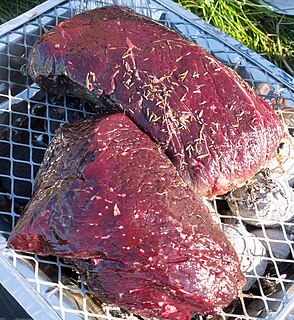 W
WWhale meat, broadly speaking, may include all cetaceans and all parts of the animal: muscle (meat), organs (offal), skin (muktuk), and fat (blubber). There is relatively little demand for whale meat, compared to farmed livestock. Commercial whaling, which has faced opposition for decades, continues today in very few countries, despite whale meat being eaten across Western Europe and colonial America previously. However, in areas where dolphin drive hunting and aboriginal whaling exist, marine mammals are eaten locally as part of a subsistence economy: the Faroe Islands, the circumpolar Arctic, other indigenous peoples of the United States, St. Vincent and the Grenadines, some of villages in Indonesia and in certain South Pacific islands.